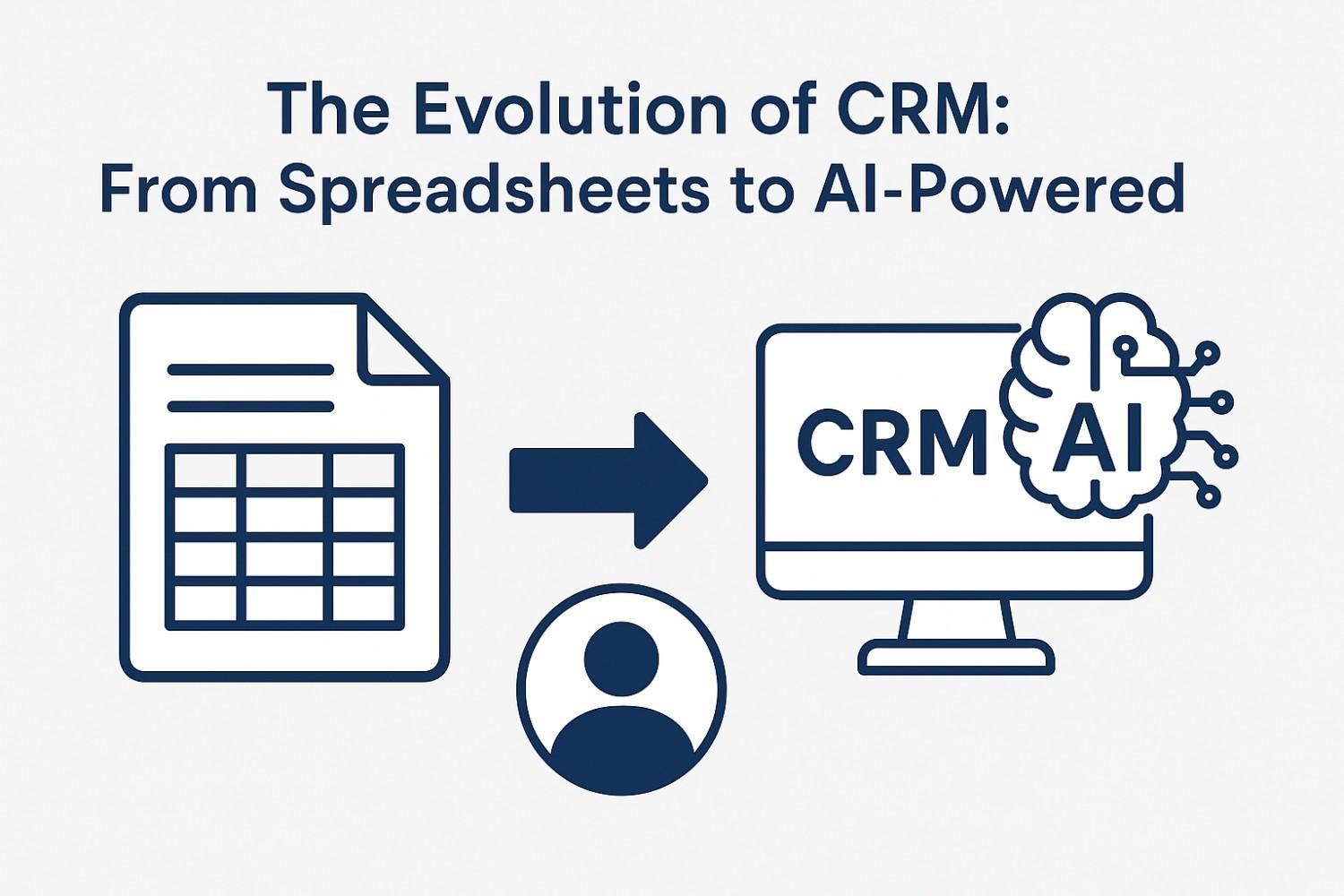The Evolution of CRM: From Spreadsheets to AI-Powered
Once upon a time (and by “time,” we mean the mid-90s when dial-up tones still haunted our dreams), customer relationship management was nothing more than a spreadsheet. Names, phone numbers, maybe a “last contacted” column if you were feeling fancy. It was simple, sure—but also chaotic enough to make you question whether customer “relationships” were supposed to involve this much hair-pulling.
Fast-forward to today, and CRM systems are not only sleek, automated, and cloud-powered—they’re also learning to predict what your customer wants before they do. (Somewhere, a dusty Excel sheet is quietly weeping in irrelevance.)
But how exactly did we get here? Let’s take a brisk walk down memory lane—coffee in hand, of course.
Stage One: The Spreadsheet Era (a.k.a. “Abandon Hope, All Who Enter”)
Spreadsheets were the original CRM. Yes, they kept customer data in rows and columns, but they also invited chaos like ants at a picnic. One typo in a phone number, one forgotten update in the “status” column, and suddenly your sales team was calling the wrong customer—or worse, calling the same customer twice with the same awkward sales pitch.
We’ve all seen those monstrous Excel files with color-coded chaos, hidden columns, and formulas that only one person in the office actually understood. (And when that person quit, well, let’s just say therapy bills skyrocketed.)
Stage Two: The Rise of On-Premise CRM
The late 90s and early 2000s gave us something magical: dedicated CRM software. It was clunky, yes, and installation usually required a server room that looked like NASA mission control—but it was progress.
Companies could now centralize customer data. Sales teams finally had a “single source of truth” (though, to be fair, it often took three logins and an IT degree just to find it). These systems worked, but they were expensive, rigid, and allergic to customization. Want a new feature? Congratulations, you’ll need to hire a small army of consultants.
Stage Three: Cloud-Based CRM (The SaaS Renaissance)
Then came the cloud—a phrase that once sounded suspiciously like a weather forecast but turned out to be the lifeline businesses didn’t know they needed. Suddenly, CRMs didn’t require you to mortgage your office for servers. Instead, they lived online, accessible anytime, anywhere (even from your phone, which, back then, was a Blackberry that refused to die).
This was the beginning of true scalability. Updates became seamless, costs dropped, and teams could actually collaborate without emailing 37 versions of the same file. The SaaS revolution didn’t just make CRM easier; it made it human-friendly.
Stage Four: Mobile CRM (Because Nobody Sits at Their Desk Anymore)
With cloud came mobility. Sales reps no longer needed to lug laptops or printouts to meetings—they could pull up real-time customer data on their phones before shaking hands (or, in the era of fist bumps, giving a polite nod).
This shift was about more than convenience; it redefined how fast businesses could respond to customers. That “let me get back to you tomorrow” line? Outdated. Mobile CRM made “instant” the new normal.
Stage Five: AI-Powered CRM (Where We Are Today)
And here we are—the age of AI. CRMs today don’t just store data; they interpret it, predict it, and, occasionally, know more about your customers than you do. From chatbots that answer queries at 2 a.m. to predictive analytics that tell your sales team which leads are worth chasing, AI has transformed CRM from a data bucket into a strategic powerhouse.
Of course, with great power comes great… well, slightly creepy vibes. (Yes, it’s convenient that your CRM suggests emailing “John” right after he clicks a product link—but also, John might start wondering if his laptop has eyes.)
Personal Observation:
We once worked with a client who proudly told us their “CRM system” was a Google Sheet with 12 tabs, color-coded “for efficiency.” It took us two weeks to gently explain that no, conditional formatting was not a long-term sales strategy. They’ve since upgraded to a modern system and—shockingly—have stopped losing track of leads somewhere between tab seven and tab nine. Progress!
Why This Evolution Matters
The CRM journey isn’t just a tech upgrade—it’s a reflection of how customer relationships themselves have changed. Customers expect speed, personalization, and care that feels authentic (not robotic, even if robots are involved behind the scenes).
For businesses, the right CRM isn’t just software—it’s the foundation of growth. It aligns teams, saves time, and prevents you from sending “Happy Birthday” emails to people who unsubscribed two years ago.
And yes, in case you’re wondering, as a CRM Software Development Company, Kanhasoft has seen—and built—it all. From clients stuck in spreadsheet purgatory to enterprises ready for AI-driven magic, we’ve helped businesses evolve alongside CRM itself.
The Future of CRM: Where Do We Go From Here?
If history has taught us anything, it’s this: CRM will keep evolving. The future promises deeper integrations, smarter automation, and possibly systems that can read your tone of voice and tell you to take a coffee break before you accidentally send a snippy email.
Will AI completely take over CRM? Probably not (customers still appreciate a human touch). But will it continue to sharpen how businesses understand and serve their clients? Absolutely.
Final Thoughts
The evolution of CRM mirrors the evolution of business itself—from clunky, manual processes to sleek, AI-assisted systems that help us work smarter, not harder. Spreadsheets had their moment, but the future belongs to CRMs that think, learn, and adapt.
And if you’re still managing customer data in Excel… well, let’s just say the 90s called, and they’d like their workflow back.
At Kanhasoft, we believe CRM isn’t just about managing data—it’s about empowering relationships. And relationships, after all, never go out of style.
FAQs About CRM Evolution
Q1: Why did businesses move away from spreadsheets for CRM?
Because spreadsheets were fine for small data sets—but when you’re managing hundreds or thousands of customers, they quickly become messy, error-prone, and impossible to scale.
Q2: What’s the biggest advantage of cloud-based CRM?
Accessibility. Cloud CRM lets teams access data from anywhere, collaborate in real time, and avoid the nightmare of server maintenance.
Q3: Is AI in CRM overhyped?
Not at all—though it’s not magic either. AI helps analyze patterns, predict customer behavior, and automate tasks, but human strategy is still key.
Q4: How do I know if my business is ready for AI-powered CRM?
If you’re already drowning in data but struggling to make sense of it, AI-powered CRM could help you prioritize leads, automate routine tasks, and deliver better customer experiences.
Q5: Can small businesses afford modern CRM systems?
Yes! Many modern CRM solutions are scalable and affordable. Start small, and grow as your needs evolve.



